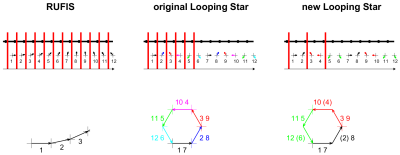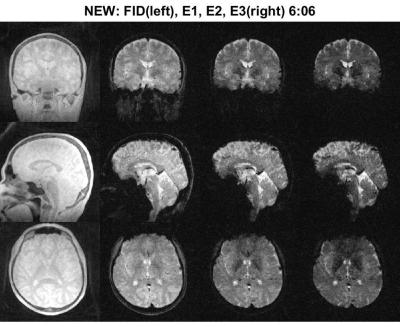3733
Looping Star: Revisiting echo in/out separation
Florian Wiesinger1,2 and Ana Beatriz Solana1
1GE Healthcare, Munich, Germany, 2King's College London, London, United Kingdom
1GE Healthcare, Munich, Germany, 2King's College London, London, United Kingdom
Synopsis
Recently, we introduced a new MR pulse sequence, termed Looping Star, for fast and yet quiet 3D radial, multi-gradient echo MR imaging. The method is based on the 3D radial Rotating Ultra-Fast Imaging Sequence (RUFIS, aka Zero TE) extended by a time-multiplexed gradient refocusing mechanism; providing an initial free-induction-decay (FID) image followed by equidistant gradient echo (GRE) images. In its original implementation, the method was affected by overlapping echo in/out signals. Here we present a solution to this problem, allowing faster scanning and/or higher resolution.
INTRODUCTION
Recently, we introduced a novel MR pulse sequence for fast and yet quiet 3D radial, multi-gradient echo MR imaging. The method was termed Looping Star1, reflecting its circular k‐space traverse and the 3D radial image encoding. Looping Star was demonstrated for quiet, submillimeter T2* and QSM imaging, and quiet BOLD fMRI1-3.The Looping Star pulse sequence is based on the 3D radial Rotating Ultra‐Fast Imaging Sequence (RUFIS)4, extended by a time‐multiplexed gradient‐refocusing mechanism. Accordingly, Looping Star captures an initial free-induction-decay (FID) image followed by gradient echo (GRE) images at equidistant echo times. In the original implementation of Looping Star, gradient refocusing was affected by overlapping echo-in and echo-out signals. The associated artifact needed correction either via filtering (halving resolution), or an extra acquisition with alternating RF phase cycling (doubling scan time).
Here now we present an improvement of the original Looping Star method, which eliminates the echo in/out overlap and associated artifacts, allowing faster scanning and/or higher resolution.
METHODS
RUFIS4 (Fig. 1 left) can be considered the simplest possible pulse sequence, consisting of 1) a constant readout gradient (black line) with only minor directional gradient updates (black dot) in between repetitions (hence silent) and 2) ultra-short, hard-pulse RF excitation (red) such that the excitation bandwidth encompasses the full imaging bandwidth. With the readout gradient active the whole time, image encoding starts effectively at the moment of RF excitation resulting in center-out radial sampling with TE = 0 (hence often referred to as Zero TE).In standard Looping Star (Fig. 1 middle), the RUFIS sequence is divided into an RF excitation phase (left) and a gradient refocusing phase (right) using a self-refocusing k-space trajectory. In the example shown, six FID signals are excited and encoded using 3D radial spokes with a relative phase of 60deg. By repeating the same spokes during the refocusing phase, all excited FID signals are looping along a hexagonal trajectory back into center of k-space forming a gradient echo. During the refocusing, the signal of the current spoke (echo-out) overlaps with the next refocusing spoke (echo-in), resulting in artifacts. Previously, the echo in/out overlap problem was addressed via filtering (halving resolution), or RF-phase cycling (doubling scan time).
The new Looping Star scheme (Fig. 1 right) addresses the echo in/out problem by exciting only every second spoke during the exciting phase. As a consequence, the echo in/out signals are now separated such as to not overlap during the refocusing phase. [In the example shown, only three FID center-out signals (1, 3, 5) are excited. During the refocusing, (6 & 7) capture the echo-in/out signal of 1; (8 & 9) capture the echo-in/out of 3; (10 & 11) capture the echo-in/out signal of 5.]
For 3D spatial encoding, the loops and its constituent spokes must be sampled along different directions. The orientation of the loops was numerically optimized for uniform sampling density. The new Looping Star pulse sequence was implemented and tested on a 3T GE MR750w scanner using an 8-channel brain coil (GE Healthcare, Chicago, IL). Image reconstruction was implemented offline in Matlab (Mathworks, Natick, MA) using standard 3D nearest-neighbor gridding5.
RESULTS
Figure 2 shows phantom results comparing original vs. new Looping Star (FOV=192mm, res=1mm, BW=±31.25kHz, FA=2, NSpkPerLoop=8, Nloop=4, ΔTE=14.8ms, LAeq=68.4dB(A)). The overlapping echo in/out signals generate spatially-incoherent, noise-like background, which can be corrected via filtering (reducing resolution), or RF phase cycling (doubling scan time). The new Looping Star method intrinsically avoids echo in/out overlap resulting in a sharp image with clean background while still maintaining resolution and scan time.Figure 3 illustrates corresponding in-vivo brain images for the new Looping Star method (same parameters as above), demonstrating 3D high-resolution, quiet imaging, providing an FID image (left) and three equidistant GRE images with ΔTE=14.8ms.
Figure 4 compares a quiet fMRI protocol (FOV=19.2mm, res=3mm, BW=±31.25kHz, FA=2, NSpkPerLoop=32, Nloop=2, ΔTE=26.88ms, LAeq=66.9dB(A)) for conventional Looping Star with phase cycling and the new Looping Star method (each fully sampled and 4x accelerated). The new Looping Star method demonstrates similar resolution and image quality but 2x shorter scan time.
DISCUSSION
Looping Star is a new concept for acquiring FID and GRE images in an efficient and yet quiet manner. The described improvement eliminates echo in/out signal overlap and thereby increases scan efficiency in terms of resolution and/or scan time. The new Looping Star method samples twice as many spokes for the GRE image (echo in/out) compared to the FID image (echo out only), which is a favorable tradeoff given the higher prevalence of GRE information. Fewer excitations also allows higher flip angles and hence higher SNR.All results shown were obtained using a simplistic, nearest-neighbor 3D gridding reconstruction5. Given its 3D radial center-out sampling significant scan acceleration is anticipated by using more advanced image reconstruction methods5,6.
From an application perspective, we expect Looping Star to be particularly useful for T2* BOLD fMRI, where its quiet imaging performance enables new investigations (e.g. auditory, sleep, resting state, …) and/or scanning patients who otherwise would not tolerate a loud MR scanner environment.
Acknowledgements
No acknowledgement found.References
- Wiesinger, F., Menini, A., & Solana, A. B. (2019). Looping Star. Magnetic resonance in medicine, 81(1), 57-68.
- Dionisio-Parra, B., Wiesinger, F., Burschka, D., Sämann, P., Czisch, M., and Solana, A. (2020). Quiet T2* Looping-Star fMRI in cognitive tasks and resting-state. Journal of Magnetic Resonance Imaging: accepted.
- Damestani, N.L., Lythgoe, D.J., Wiesinger, F., Solana, A.B., Williams, S.C.R., and Zelaya, F. (2019). Looping Star silent fMRI: a platform for improving studies of auditory processing. In Proceedings of the 27th Annual Meeting of ISMRM. Montreal, Canada. Abstract 0363.
- Madio, D. P., & Lowe, I. J. (1995). Ultra‐fast imaging using low flip angles and FIDs. Magnetic resonance in medicine, 34(4), 525-529.Oesterle, C., Markl, M., Strecker, R., Kraemer, F. M., & Hennig, J. (1999). Spiral reconstruction by regridding to a large rectilinear matrix: a practical solution for routine systems. Journal of Magnetic Resonance Imaging: An Official Journal of the International Society for Magnetic Resonance in Medicine, 10(1), 84-92.
- Pruessmann, K. P., Weiger, M., Scheidegger, M. B., & Boesiger, P. (1999). SENSE: sensitivity encoding for fast MRI. Magnetic resonance in medicine, 42(5), 952-962.
- Lustig, M., Donoho, D., & Pauly, J. M. (2007). Sparse MRI: The application of compressed sensing for rapid MR imaging. Magnetic Resonance in Medicine: An Official Journal of the International Society for Magnetic Resonance in Medicine, 58(6), 1182-1195.
Figures

Figure 1: Illustration of RUFIS (left) and original (middle) and new (right) Looping Star. The readout gradient (black) is kept constant
with only directional updates. RF excitations are indicated
by red lines. In Looping Star readout directions are chosen
such as to form a looping trajectory. Originally echo-out
signals are overlapping with incoming echo-in signals. This is avoided in the new Looping Star
scheme by pulsing only every second spoke during the excitation phase.

Figure
2: Comparison of the original (left) vs.
the new (right) Looping Star method (FOV=192mm, res=1mm, BW=±31.25kHz, FA=2,
NSpkPerLoop=8, Nloop=4, ΔTE=14.8ms, LAeq=68.4dB(A)). The original Looping Star method was tested
using either no echo in/out separation, filtering (FILT), or RF phase cycling
(PC).

Figure
3: Illustration of the new Looping Star method for in-vivo brain imaging (FOV=192mm, res=1mm, BW=±31.25kHz, FA=2,
NSpkPerLoop=8, Nloop=4, ΔTE=14.8ms, LAeq=68.4dB(A)) showing the FID (left), as
well as corresponding first (E1), second (E2) and third (E3, right) GRE image.

Figure
4: Comparison of Looping Star fMRI
protocols (FOV=192mm, res=3mm, BW=±31.25kHz, FA=2, NSpkPerLoop=32, Nloop=2,
ΔTE=26.88ms, LAeq=66.9dB(A)) without (x1) and with (x4) scan acclearation.